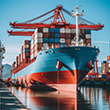Selecting and Managing Transportation Modes: A Strategic Approach to Cargo Movement
Introduction: The Critical Decision of Transportation Mode Selection
Choosing the right transportation mode is a pivotal decision in logistics that directly impacts cost, efficiency, reliability, and customer satisfaction. This comprehensive guide explores the intricacies of selecting and managing transportation modes for optimal cargo movement.
Understanding Transportation Modes
Primary Transportation Modes
- Road Transportation
- Flexibility and door-to-door service
- Ideal for short to medium-distance shipments
- Versatile for various cargo types
- Rail Freight
- Excellent for long-distance, bulk cargo
- Cost-effective for heavy and large volume shipments
- More environmentally friendly compared to road transport
- Sea Freight
- Most economical for international and intercontinental shipments
- Massive cargo capacity
- Ideal for non-time-sensitive goods
- Air Freight
- Fastest transportation mode
- Best for time-sensitive and high-value goods
- Global reach with minimal infrastructure requirements
Decision-Making Criteria for Mode Selection
Key Factors to Consider
1. Cargo Characteristics
- Weight and Volume
- Heavy, bulky items: Sea or rail
- Light, compact items: Air or road
- Fragility
- Delicate goods: Air or specialized road transport
- Robust items: Sea or rail
- Value
- High-value items: Air with enhanced security
- Low-value bulk goods: Sea or rail
2. Time Constraints
- Delivery Urgency
- Immediate delivery: Air freight
- Flexible timelines: Sea or rail
- Supply Chain Timing
- Just-in-time manufacturing: Faster modes
- Inventory build-up: Slower, cost-effective modes
3. Cost Considerations
- Transportation Expenses
- Lowest cost: Sea freight
- Highest cost: Air freight
- Total Landed Cost
- Include insurance, handling, customs
- Consider indirect costs of slower modes
4. Geographic and Infrastructure Constraints
- Route Availability
- Remote locations: Multimodal approaches
- Well-connected regions: Multiple mode options
- Infrastructure Quality
- Road conditions
- Port and airport capabilities
- Rail network development
Multimodal Transportation Strategies
Integrated Transportation Approach
- Combining Multiple Modes
- Leverage strengths of different transportation types
- Optimize cost and efficiency
- Intermodal Transportation
- Seamless cargo transfer between modes
- Standardized containers
- Reduced handling costs
Technology-Enabled Mode Management
Advanced Management Tools
- Real-Time Tracking Systems
- GPS monitoring
- Instant visibility across transportation modes
- Predictive Analytics
- Route optimization
- Performance prediction
- AI-Driven Decision Support
- Automated mode selection
- Dynamic routing adjustments
Risk Management in Transportation Mode Selection
Mitigation Strategies
- Diversification
- Multiple transportation providers
- Backup mode options
- Comprehensive Insurance
- Mode-specific coverage
- Cargo protection strategies
- Compliance Management
- Regulatory adherence
- International shipping regulations
Sustainability Considerations
Green Transportation Approaches
- Emission Reduction
- Low-carbon transportation modes
- Efficient routing
- Alternative Fuel Technologies
- Electric and hybrid vehicles
- Sustainable shipping practices
- Carbon Offset Programs
Cost-Benefit Analysis Framework
Comprehensive Evaluation Method
- Calculate direct transportation costs
- Assess indirect expenses
- Evaluate time-to-market
- Consider reliability metrics
- Factor in environmental impact
Decision Matrix: Mode Selection Guide
| Factor | Road | Rail | Sea | Air |
|---|---|---|---|---|
| Speed | Moderate | Slow | Slowest | Fastest |
| Cost | Moderate | Low | Lowest | Highest |
| Capacity | Low-Medium | High | Very High | Low |
| Flexibility | Very High | Low | Low | Moderate |
| Environmental Impact | Moderate | Low | Lowest | Highest |
Emerging Trends in Transportation Mode Management
- Autonomous Transportation
- Drone Delivery Technologies
- Hyperloop and Advanced Rail Systems
- Sustainable Propulsion Methods
Conclusion: Strategic Mode Selection as a Competitive Advantage
Effective transportation mode selection is more than a logistical decision—it’s a strategic business imperative that directly influences operational efficiency, customer satisfaction, and competitive positioning.
Key Takeaways
- Holistic approach to mode selection
- Leverage technology for informed decisions
- Prioritize flexibility and sustainability
- Continuous evaluation and adaptation
Strategic Insight: Transportation mode selection is a dynamic process requiring ongoing analysis, technological integration, and strategic thinking.






